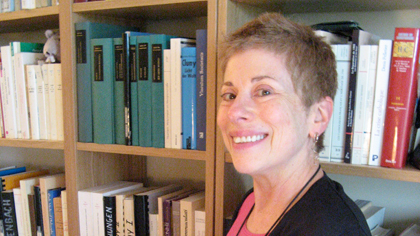archive
Barbara Rosenwein Discusses Teaching the History of Emotions

Graduate students of all specialties will have a unique opportunity in fall 2014 to learn about the history of emotions from one of the pioneers in that field. Dr. Barabara Rosenwein recently took time to answer some questions about HIST 410: The History of Emotions, and the field in general. You can preview the course by downloading the HIST 410 syllabus. As Dr. Rosenwein nears the end of her teaching career, there is no better time to enjoy her wealth of knowledge.
Describe the course structure of History 410: History of Emotions. What is unique about it—compared to other topic courses that you have taught in the past?
In no other topics course do I assign a psych textbook on anything; in this one, I do. In addition, this course devotes some time to methods: How do historians study emotions? What other methods might be possible? Beyond that the course structure isn’t all that different from other topic courses that I’ve taught. We’ll read lots of articles and a few books, devote some classes to reports, reserve some class time for private meetings between me and individual students, and (for students who want to get seminar credit), we’ll end with a mini-conference at which the seminar students will present their work.
In what ways will your course benefit students working outside of your period of specialization, medieval history?
I’m one of only a very few medievalists who works on the history of emotions. Most of the others are modernists--either of European or U.S. history. The sources are better and more varied for those fields. It’s not like emotions started and ended in the Middle Ages! Consider Oprah Winfrey’s website. It’s full of emotions and it assumes its visitors will be interested in them too. There are so many terrific topics of research that students could embark on outside of the medieval period: comparing emotions in Bollywood films with those of Hollywood; comparing the emotions that Oprah’s admirers care about with those that, say, read Parent’s Magazine. Or looking at changing emotions attached to war--or nationalism, or politicians-- in twentieth-century England. Public historians could think about what emotional effects a museum exhibit or a monument might have, not to mention what a new housing development might mean to old-timers in a neighborhood. The field is so open!
What are some the most essential tenets to the historical study of emotions? What disciplines outside of history inform the field?
The history of emotions is really a new field and rather contentious! So when you ask about essential tenets, the answer is that there are none. There are historians, for Jan Plamper, for example, who think that current scientific studies of emotions are irrelevant to historical studies. In his view, scientists today “essentialize” what is really a constantly changing, socially constructed phenomenon. On the other hand some historians, William Reddy, for example, go first to the sciences (experimental psychology and neuroscience) to understand emotions of the past. And then there are lots of historians in between. For more on this discussion see this American Historical Review roundtable; we’ll read the article itself in Hist 410.
When did historians begin to isolate emotions as a unique field of study?
Although historians have always talked about emotions (when Nero died, “the senators were ‘joyous,’” says the Roman historian Tacitus) the modern field of emotions studies began in the 1940s in Europe and in the 1980s in the United States. The European tradition was founded by Norbert Elias, whose book The Civilizing Process is still considered authoritative by many. (We’ll read excerpts in Hist 410). The American strand was started by Peter Stearns and his then-wife Carol Stearns, who argued in the American Historical Review that historians should study changing emotional standards. They used advice books and child-rearing manuals to demonstrate a great change in emotional expectations in the U.S. from the Victorian era to the modern, with the turning point in the 1920s.
Why did you decide to offer this course now?
I’m writing a book on emotions from 600 to 1700. That’s a big stretch. I think a class like this offers an exciting chance for me to learn and discuss materials outside of my comfort zone, and it’s a great chance for students to do the same for themselves.
